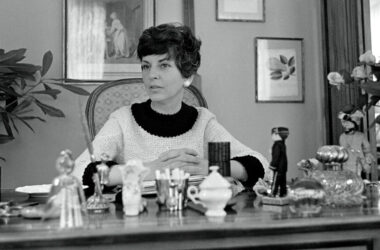Claude Montana, the audacious and haunted French designer whose exquisite tailoring defined the big-shouldered power look of the 1980s — an erotic and androgynous tough chic that brought him fame and accolades until he was felled by drugs and tragedy in the ’90s — died on Friday in France. He was 76.
The Fédération de la Haute Couture et de la Mode confirmed the death but did not specify a cause or say where he died.
Mr. Montana was among a cohort of avant-garde Parisian designers, among them Thierry Mugler and later Jean Paul Gaultier, who idealized the feminine form in extravagant, stylized ways that harked back to the screen sirens of old Hollywood, but as reconstituted in outer space. Mr. Mugler, who died in 2022, offered a campier femme fatale than Mr. Montana’s icy vision, though the two were often lumped together as the architects of the 1980s “glamazon.”
His clothes, said Valerie Steele, director of the Museum at the Fashion Institute of Technology, “were fierce, with a power that was both militaristic and highly eroticized.” She added: “It was not the American power look of the shoulder-padded executive. His was a different kind of working woman.”
Mr. Montana often drew inspiration from the after-hours world of the Paris demimonde — the sex workers and dominatrixes, the denizens of the leather bars he frequented. But he wasn’t just stamping out fetish gear.
“His tailoring was scalpel sharp,” the fashion journalist and author Kate Betts said by phone. “The level of perfectionism was intense.”
Josh Patner, a former fashion coordinator at Bergdorf Goodman, said in an interview: “His clothes were meticulous, beautiful objects. He defined the design language of his era. The 1980s power proportions, the unreasonably sleek surfaces, the hard edges made sensual.”
Shy and recessive in person, Mr. Montana was nonetheless a born showman. From his first show in 1977, when he sent out models in full leather regalia, the epaulets of their jackets looped with chains (which drew comparisons to Nazi uniforms — upsetting the designer, whose inspiration was closer to home), his Paris presentations were among the buzziest, always overseen by gatekeepers in white paper jumpsuits and shrouded in secrecy. “You waited and you waited,” Ms. Betts said, “but it was always worth it.”
Speaking to Vanity Fair, Ellin Saltzman, a former fashion director of Saks Fifth Avenue, said: “There were people who cried after Claude’s shows.” She added, “Almost Germanic in tempo, they could be very militant but totally sexy at the same time.”
Claude Montamat was born on June 29, 1947, in Paris, one of three siblings. He changed his surname in the 1970s, because, he said, people kept mispronouncing it. His mother was German; his father, a fabric manufacturer, was Spanish. The family was well-to-do.
“Very bourgeois,” he told The Washington Post in 1985. “They wanted me to be something I did not want to be.”
He left home when he was 17 and moved to London, where he began making papier-mâché jewelry that was featured on the cover of British Vogue. But back home in Paris, where he returned in 1973, he couldn’t find a market for his pieces and, through a friend, landed a job as a cutter for Mac Douglas, a luxury leatherwear company. A year later, he was the company’s chief designer. By 1977, he was on his own.
By the end of the decade he was a star, and his styles would dominate the ’80s. Critics called him the future of Paris fashion. He had licensing deals, a boutique, a best-selling perfume and men’s and women’s ready-to-wear lines; he designed for an Italian line, Complice. Eighties cynosures like Cher, Diana Ross and Grace Jones all wore Montana. So did Don Johnson and Bruce Willis.
“He was a great, great designer,” Ms. Steele said, “but he had demons.”
Ensnared in drugs, he often disappeared for days or weeks at a time. In 1989, when Dior came calling, he turned the job down. “I need room,” he told The Washington Post that year. “I don’t want to have all this money and go to an asylum.”
Yet a year later he accepted Lanvin’s offer to design its haute couture line, and he did so for five seasons. “His new space maidens are a gentler race, wearing soft silk clothes with small waistlines and spreading skirts,” Bernadine Morris wrote in one review in The Times. “His collection was a perfect cameo expressing couture’s latest new era.”
But many critics panned the new work — Mr. Montana’s asymmetrical sheaths and beaded tops may have been too minimal for the ladies of couture — and he was let go.
Wallis Franken was an American model with two children who had been Mr. Montana’s muse and runway star since he started out. They shared a taste for nightlife and cocaine, and, by her account, Ms. Franken was always deeply in love with him. Their marriage in 1993 was seen by some, however, as a manipulation on his part to revive his business, a cynical “mariage blanc.”
In any case, their relationship, as Maureen Orth reported in Vanity Fair in 1996, was stormy. She resented his affairs with men, and he resented her work; he once beat her, Ms. Orth wrote, when the photographer Steven Meisel asked her to pose for a Donna Karan campaign.
Three years after their wedding, Ms. Franken’s body was found on the street outside their Paris apartment. Tortured by her own drug use and despondent over her marriage, Ms. Franken had told friends she had contemplated suicide. But people whispered: Had she been pushed?
“Whatever I am suffering, I am because I am,” Mr. Montana told The Washington Post. “I wonder many times why do I have to go through that pain.”
Mr. Montana continued to put out collections until the turn of the millennium, and critics invariably described them in lackluster terms. By the 2000s he had became a recluse, even as younger designers turned to his bold styles for inspiration.
“There was a sense that Claude would go on and last forever,” Dawn Mello, a former Bergdorf Goodman fashion director, told Vanity Fair in 2013. “Then he disappeared and fell off the map.”
The designer Lawrence Steele, speaking from Milan, recalled that one of the first pieces of fashion he bought was a floor-length navy blue Claude Montana cashmere coat, with shoulder pads “out to here,” as he put it.
“It was 1983 and I had a buzz cut so I looked like Grace Jones and I felt extremely fabulous,” Mr. Steele said. “His clothes gave you a larger-than-life persona. They were like pure ego and strength. And that’s what the ’80s was about in general: this pure, powerful proudness of being.”
Vanessa Friedman contributed reporting.






